![]()
![]()
![]()
Use LEFT and RIGHT arrow keys to navigate between flashcards;
Use UP and DOWN arrow keys to flip the card;
H to show hint;
A reads text to speech;
53 Cards in this Set
- Front
- Back
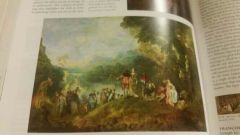
|
Antoine Watteau Pilgrimage to Cythera Rococo 1717 Watteau's fete galante paintings depict the outdoor amusements of French upper-class society. The haze of color, subtly modeled shapes, gliding motion, and air of suave gentility match Rococo taste. |
|
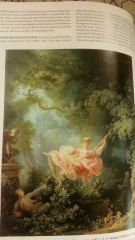
|
Jean Honore FragonardThe SwingRococo1766Fragonard's Swing epitomizes Rococo style. Pastel colors and soft light complement a scene in which a young lady flirtatiously kicks off her shoe at a statue of Cupid while her lover watches. |
|
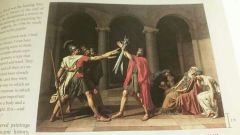
|
Jaques - Louis David Oath of Horatii 1784 David was the Neoclassical painter-ideologist of the French Revolution. This huge canvas celebrating ancient Roman patriotism and sacrifice features statuesque figures and classical architecture.
|
|
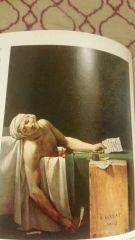
|
Jaques - Louis David Death of Marat 1793 David depicted the revolutionary Marat as a tragic martyr, stabbed to death is his bath. Although the painting displays severe Neoclassical spareness, it's convincing realism conveys pain and outrage. |
|
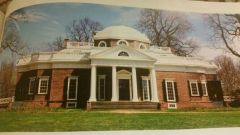
|
Thomas Jefferson Monticello 1770-1806 Jefferson let the movement to adopt Neoclassical as the architectural style of the United States. Although built of local materials, his Palladium Virginia home recalls Chiswick House. |
|
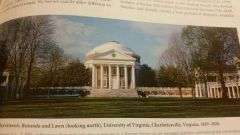
|
Thomas Jefferson Rotunda and Lawn 1819-1826 Modeled on the Pantheon, Jefferson's Rotunda sits like a temple in a Roman forum on an elevated platform overlooking the colonnade Lawn of the University of Virginia. |
|
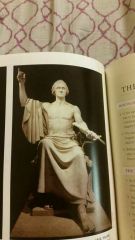
|
Horatio Greenough George Washington 1840 In this posthumous portrait, Greenough likened Washington to a god by depicting him seminude and enthroned in the manner of Phidias's Olympian statue of Zeus, king of the Greek gods. |
|

|
Jaques - Louis David Coronation of Napoleon 1805-1808 As First Painter of the Empire, David recorded Napoleon at his December 1804 coronation crowning his wife with the pope as witness, thus underscoring the authority of the state over the church. |
|

|
Jean - August - Dominique Ingres Grande Odalisque 1814 The reclining female nude was a Greco-Roman subject, but Ingres converted his Neoclassical figure into an odalisque in a Turkish harem, consistent with the new Romantic taste for the exotic. |
|
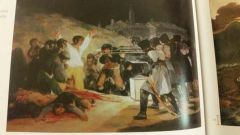
|
Francisco Goya Third of May 1808 Goya encouraged empathy for the massacred Spanish peasants by portraying horrified expressions on their faces, endow in them with a humanity lacking in the French firing squad. |
|
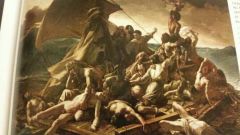
|
Theodore Gericault Raft of the Medusa 1818-1819 In this gigantic history painting, Gericault rejected Neoclassical compositional principles and, in the Romantic spirit, presented a jumble of writhing bodies in every attitude of suffering, despair, and death. |
|
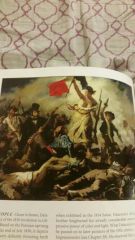
|
Eugene Delacroix Liberty Leading the People 1830 In a balanced mix of history and poetic allegory, Delacroix captured the passion and energy of the 1830 revolution in this painting of Liberty leading the Parisian uprising against Charles X. |
|
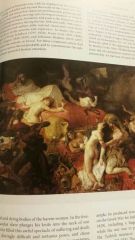
|
Eugene Delacroix Death of Sardanapalus 1827 Inspired by Byron's 1821 poem, Delacroix painted the Romantic spectacle of an Assyria king on his funeral pyre. The richly colored and emotionally charged canvas is filled with exotic figures. |
|
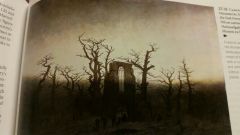
|
Caspar David Friedrich Abbey in the Oak Forest 1810 Friedrich was a master of the Romantic transcendental landscape. The reverential mood of this winter scene with a ruined Gothic church and cemetery demands the silence appropriate to sacred places. |
|
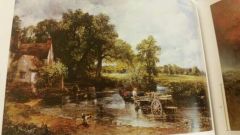
|
John Constable the Haywain 1821 The Haywain is a nostalgic view of the disappearing English countryside during the Industrial Revolution. Constable had a special gift for capturing the texture that climate and weather give to landscape. |
|

|
Joseph Mallory William Turner The Slave Ship 1840 The essence of Turner's innovative style is the emotive power of color. He released color from any defining outlines to express both the forces of nature and the painter's emotional response to them. |
|
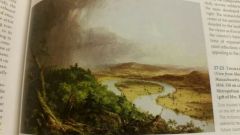
|
Thomas Cole The Oxbow 1836 Cole divided his canvas into dark wilderness on the left and sunlit civilization on the right. The miniscule painter at the bottom center seems to be asking for advice about America's future course. |
|
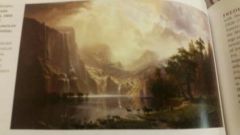
|
Albert Bierstadt Among the Sierra Nevada Mountains 1868 Bierstadt's panoramic landscape presents the breathtaking natural beauty of the American West, reinforcing the 19th century doctrine of Manifest Destiny, which justified America's western expansion. |
|

|
Gustave Courbet The Stone Breakers 1849 Courbet was the leading figure in the Realist movement. Using a palette of dirty browns and grays, he conveyed the dreary anf dismal nature of menial labor and mid-19th-century France. |
|
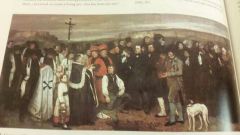
|
Gustave Courbet Burial at Ornans 1849 Although as monumental in scale as the traditional history painting, Burial at Ornans horrified critics because of the ordinary nature of the subject and Courbet's starkly antihero composition. |
|
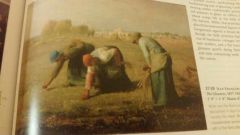
|
Jean-Francois Millet The Cleaners 1857 Milletand the Barbizon School painters specialized in depictions of French country life. Here, Millet portrayed three impoverished women gathering the scraps left in the field after a harvest. |
|
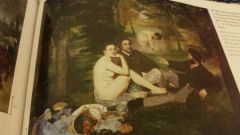
|
Edouard Manet Luncheon on the Grass 1863 Manet shocked his contemporaries with both his subject matter and manner of painting. Moving away from illusionism, he used colors to flatten form and to draw attention to the painting surface. |
|

|
Edouard Manet Olympia 1863 Manet's painting of a nude prostitute and her black maid carrying a bouquet from a client scandalized the public. Critics also faulted his rough brushstrokes and abruptly shifting tonalities. |
|
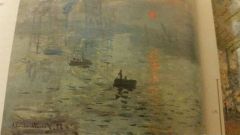
|
Claude Monet Impression: Sunrise 1872 A hostile critic applied the derogatory term impressionism to this painting because of its sketchy quality and undistinguished brushstrokes. Monet and his circle embraced the label for their movement. |
|
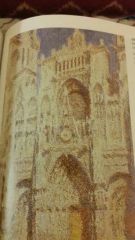
|
Claude Monet Rouen Cathedral 1894 Monet painted a series of views of Rouen Cathedral at different times of day and under various climatic conditions. The real subject of this painting is not the building but the sunlight shining on it. |
|

|
Pierre Auguste Renoir Le Moulin de la Galette 1876 Renoir's painting of this popular Parisian dance hall is dappled by sunlight and shade, artfully blurred into the figures to produce the effect of floating and fleeting light in the impressionists cultivated. |
|
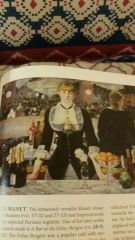
|
Edouard Manet Bar at the Folies-Bergere 1882 In this painting set in a Parisian cafe, Manet called attention to the canvas surface by creating spatial inconsistencies, such as the relationship between the barmaid and her apparent reflection in a mirror. |
|
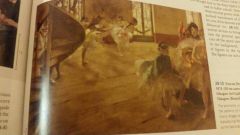
|
Edgar Degas The Rehearsal 1874 The arbitrary cut-off figures of dancers, the patterns of light splotches, and the blurry images reveal Degas's interest in reproducing fleeting moments, as well as his fascination with photography. |
|
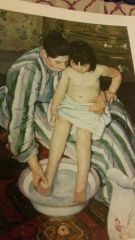
|
Mary Cassatt The Bath 1892 Cassatt ' compositions owe much to Degas and Japanese prints, but her subjects differ from those of most Impressionist painters, in part because, as a woman, she could not frequent cafes. |
|
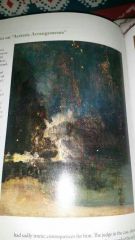
|
James Abbott McNeill Whistler Nocturne in Black and Gold 1875 In this painting, Whistler displayed an Impressionist's interest in conveying the atmospheric effects of fireworks at night, but he also emphasized the abstract arrangement of shapes and colors. |
|
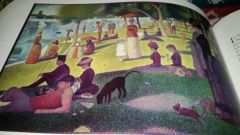
|
Georges Seurat A Sunday on La Grande Jatte 1884-1886 Seurat's color system, pointillism, involved dividing colors into their component parts and applying those colors to the canvas in tiny dots. The forms become comprehensible only from a distance. |
|
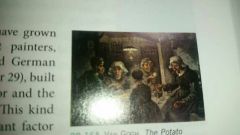
|
Vincent Van Gogh The Potato Eaters 1885 |
|
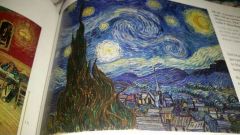
|
Vincent Van Gogh Starry Night 1889 In this late work, van Gogh painted the vast night sky filled with whirling and exploding stars, the earth huddled beneath it. The painting is an almost abstract pattern of expressive line, shape, and color. |
|
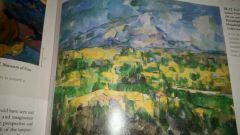
|
Paul Cezzane Mont Sainte-Victoire 1902-1904 In his landscapes, Cezzane replaced the transitory visual effects of changing atmospheric conditions, the impressionists focus, with careful analysis of the lines, planes, and colors of nature. |
|

|
Paul Cezzane Basket of Apples 1895 Cezzane's still life's reveal his analytical approach to painting. He captured the solidity of bottles and fruit by juxtaposing color patches, but the resulting abstract shapes are not optically realistic. |
|
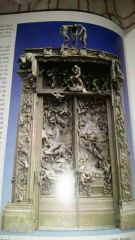
|
Auguste Rodin The Gates of Hell 1880- 1900 Rodin's most ambitious work, inspired by Dante's Inferno and Ghiberti's Gates of Paradise, presents nearly 200 tormented sinners in relief below The Three Shades and The Thinker. |
|
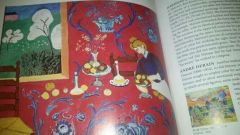
|
Henri Matisse Harmony in Red 1908-1909 Matisse believed painters should choose compositions and colors that express their feelings. Here. The table and wall seem to merge because they are the same color and gave identical patterning. |
|
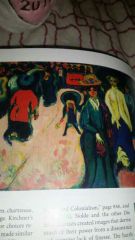
|
Ernest Ludwig Kirchner Street, Dresden 1908 Kirchner's perspective distortions, disquieting figures, and color choices reflect the influence of the Fauves and of Edvard Munch who made similar expressive use of formal elements. |
|
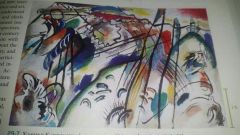
|
Vasily Kandinsky Improvisation 28 1912 The theories of Einstein and Rutherford convinced Kandinsky that material objects had no real substance. He was one of the first painters to explore complete abstraction in his canvases. |
|

|
Pablo Picasso Les Demoiselles d'Avignon 1907 African and ancient Iberian sculpture and Cezzane's late paintings influenced his pivotal work, with which Picasso opened the door to a radically new method of representing forms in space. |
|
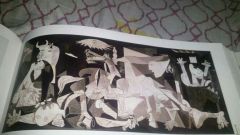
|
Pablo Picasso Guernica 1937 Picasso used Cubist techniques, especially the fragmentation of objects and dislocation of anatomical features, to expressive effect in this condemnation of the Nazi bombing of the Basque capital. |
|
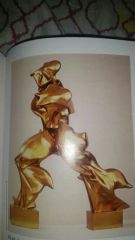
|
Umberto Boccioni Unique Forms of Continuity in Space 1913 Boccioni's Futurist manifesto for sculpture advocated abolishing the enclosed statue. This running figure's body is so expanded it almost disappears behind the blur of its movement. |
|
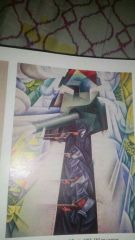
|
Gino Severini Armored Train 1915 Severini's glistening armored train with protruding cannon reflects the Futurist faith in the cleansing action of war. The painting captures the dynamism and motion central to the Futurist manifesto. |
|
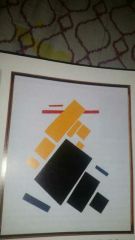
|
Kazimir Malevich Suprematist Composition: Airplane Flying 1915 Malevich developed an abstract style the called Suprematism to convey that the supreme reality in the world is pure feeling. Here, the brightly colored rectilinear shapes float against white space. |
|
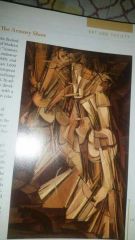
|
Marcel Duchamp Nude Descending a Staircase 1912 The Armory Show introduced European modernism to America. Duchamp's figure moving in a time continuum owes a debt to Cubism and Futurism. The press gave it a hostile reception. |
|
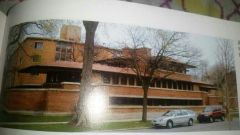
|
Frank Lloyd Wright Robie House 1907 The Robie House is an example of Wright's "architecture of democracy," in which free individuals move within a "free" space, nonsymmetrical design interacting spatially with its natural surroundings. |
|
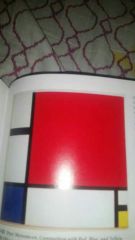
|
Piet Mondrian Composition with Red, Blue, and Yellow 1930 Mondrian's "pure plastic" paintings consist of primary colors locked into a grid of intersecting vertical and horizontal lines. By altering the grid patterns, he created a dynamic tension. |
|
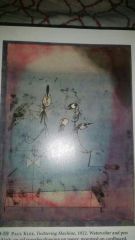
|
Paul Klee Twittering Machine 1922 Although based on forms in the tangible world easily read as birds, Klee's Twittering Machine is a fanciful vision of a mysterious world presented in a simplified, almost childlike manner. |
|
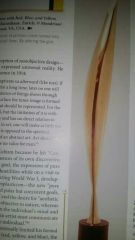
|
Constantin Brancusi Bird in Space 1923 Although not a literal depiction of a bird, Brancusi's softly curving light reflecting abstract sculpture in polished bronze suggests a bird about to soar in free flight through the heavens. |
|

|
Le Courbusier Villa Savoye 1929 Steel and ferroconcrete made it possible for Le Corbusier to invert the traditional practice of placing light architectural elements above heavy ones and to eliminate weight bearing walls on the ground story. |
|
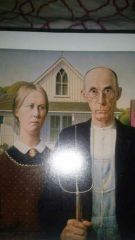
|
Grant Wood American Gothic 1930 In reaction to modernist abstract painting, the Midwestern Regionalism movement focused on American Subjects. Wood's painting of an Iowa farmer and his daughter became an American icon. |
|
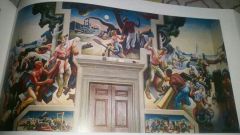
|
Thomas Hart Benton Pioneer Days and Early Settlers 1936 Benton's mural for Missouri's State Capital is one of the major Regionalism artworks. Part documentary and part invention, the images include both positive and negative aspects of state history. |
|
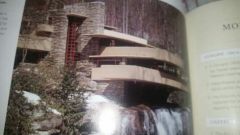
|
Frank Lloyd Wright Kaufmann House 1936 Perched on a rocky hillside over a waterfall, Wright's Fallngswater has long sweeping lines, unconfined by abrupt wall limits, reaching out and capturing the expansiveness of the natural enviromment. |

